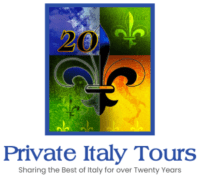He was born in the small Tuscan village of Borgo San Sepolcro, Town of the Tomb.
Tomb? Upon their return from the Holy Land, two monks, Arcanus and Giles, placed a stone they pilfered from the Holy Sepulchre in Jerusalem, giving rise to both a monastery and the town’s name.
Piero’s early training focused on mathematics, specifically as a geometer. This word, nearly lost in current English, refers to a student of geometry. Piero’s work has an attention to perspective and mathematical precision in its design. He may well have been influenced by the works of Massacio, especially that of the Holy Trinity in the Church of Santa Maria Novella in Florence. That work by Massacio was the first time classical perspective was used in Renaissance fresco.
 The name of Piero’s hometown, Town of the Tomb is most prescient, given the religious nature of the greatest masterpieces by this Renaissance artist. Experts consider History of the True Cross in the Church of San Francesco in the Tuscan city of Arezzo his earliest masterpiece. The cycle comprises ten key scenes in the story of how a tree from the Garden of Eden became the cross used for Christ’s crucifixion.
The name of Piero’s hometown, Town of the Tomb is most prescient, given the religious nature of the greatest masterpieces by this Renaissance artist. Experts consider History of the True Cross in the Church of San Francesco in the Tuscan city of Arezzo his earliest masterpiece. The cycle comprises ten key scenes in the story of how a tree from the Garden of Eden became the cross used for Christ’s crucifixion.
 In the Exaltation of the Cross, the final lunette in the fresco cycle, Piero gives the cross-piece perspective toward a vanishing point at the lower center of the scene. He cleverly creates visual depth between those who greet the procession approaching the walls of Jerusalem by placing a man, smaller than the greeters, hence showing distance between the greeters and the walls of the city.
In the Exaltation of the Cross, the final lunette in the fresco cycle, Piero gives the cross-piece perspective toward a vanishing point at the lower center of the scene. He cleverly creates visual depth between those who greet the procession approaching the walls of Jerusalem by placing a man, smaller than the greeters, hence showing distance between the greeters and the walls of the city.
 Another stunning example of creating depth is seen in the Battle of Heraclius and Chosroes. As you study the battle scene, left to right, note the foreshortened view of the black horse, the long gray spike held by the helmeted soldier (which directs the eye to the center of the scene), the reduced scale of the various flags as they fade in the distance and, most especially, the arched tabernacle whose supports return the eye of the viewer toward the central action of the fresco.
Another stunning example of creating depth is seen in the Battle of Heraclius and Chosroes. As you study the battle scene, left to right, note the foreshortened view of the black horse, the long gray spike held by the helmeted soldier (which directs the eye to the center of the scene), the reduced scale of the various flags as they fade in the distance and, most especially, the arched tabernacle whose supports return the eye of the viewer toward the central action of the fresco.
Piero published studies in the use of perspective in painting and, in the 1450s he copied and illustrated three works by Archimedes, most importantly De Prospectiva Pingendi, On Perspective in Painting.
During his lifetime, he traveled to Urbino, Rimini, Arezzo, and Florence. It was during his work in Urbino, in the service of the Federico III da Montefeltro, titled Duke in 1474, that he met and worked with the architects Francesco di Giorgio Martini and Leon Battista Alberti as well as the mathematician Fra Luca Pacioli.
It is far too easy, when viewing work like this, to accept the artist had but a rudimentary idea in mind when the work was started; such is never the case. The initial drawing of the design of scene, figure, building, and effect of nature are always carefully considered in keeping with the wishes of a patron, the church, and certainly the artist. Piero’s incredible talent in art, coupled with an unerring scientific vision as well as his lifelong fascination with mathematics and geometry all combined to form the ‘eye’ with which he approached his work.
